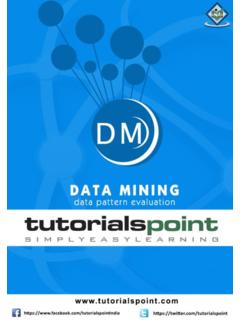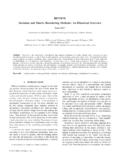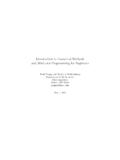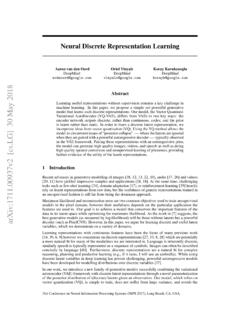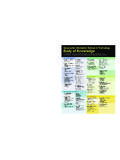Transcription of Comparison of Particle Sizing Methods - CPS …
1 CPS CPS Instruments Europe Box 180, NL-4900 AD Oosterhout, The Netherlands T: +31 (0)162 472478 F: +31 (0)162 421944 E: Comparison of Particle Sizing Methods This document is a slightly irreverent, but honest, Comparison of several different Particle Sizing Methods . It is by no means an attempt at an exhaustive survey of the Particle Sizing field, since such a survey would require a good size text book or two. Our primary objectives are: To help potential buyers of Particle Sizing instruments (especially those without a lot of Particle Sizing experience) sort through the often exaggerated claims of instrument performance. To help them appreciate that all Particle Sizing Methods have both advantages and limitations. These advantages and limitations should be understood and weighted before choosing a Particle Sizing instrument. We urge potential customers to be very cautious about accepting the performance claims of any instrument manufacturer, including CPS Instruments, and to be cautious about accepting at face value the results of any Particle Sizing instrument.
2 The truth is that while a certain Particle Sizing application may be dominated by one Sizing method, other applications are dominated by other Methods . The most sophisticated Particle Sizing customers often use completely different Sizing Methods for different applications, and even use two different Methods for the same application; these customers understand that the best choice of Sizing method depends upon both the nature of the sample and what characteristics of the size distribution are most important. One method can never suit all samples. If you read this document and find what you believe to be a substantial error of fact, please contact CPS Instruments via e-mail and tell us what you think is wrong. Particle Sizing Methods can be separated into three basic classes: Ensemble Methods : all particles in a sample are measured at the same time.
3 Size distribution data is extracted from a combined signal for all particles . Counting Methods : individual particles are measured and counts of similar size particles are places into size bins to construct a distribution. Separation Methods : an outside force/process is used to separate particles according to size. The quantities of the separated different sizes are determined. Each of these classes is covered in a separate section below. CPS CPS Instruments Europe Box 180, NL-4900 AD Oosterhout, The Netherlands T: +31 (0)162 472478 F: +31 (0)162 421944 E: 1. Ensemble Methods : Low Angle Laser Light Scattering (LALLS Laser Diffraction) This method uses a laser beam passing through a sample of particles in suspension (in liquid or air for instance), and collects light intensity data at different (low) scattering angles away from the axis of the laser beam. Intensity data is collected at many different angles (32 or more in most instruments).
4 Mie light scattering theory calculations and standard mathematical Methods for solving the inverse problem are applied to the intensity data to generate a distribution of Particle sizes that is consistent with the observed light intensities at the observed angles. LALLS is applied to relatively low concentration samples, so that there is a minimum of multiple scattering (where light scattered from one Particle is scattered by a second Particle before reaching the detectors), since multiple scattering makes it difficult to generate an accurate size distribution based on scattering angles. (a) (b) Schematic representation of the Low Angle Laser Light Scattering technique: (a) experimental set-up (LS: laser source; S: Particle suspension; DP: diffraction pattern) and (b) scattered light intensity as measured by circular light detector at the detection plane.
5 Advantages Simple and fast data collection. Very broad dynamic range (claimed from < m up to millimeter sizes). Can measure both powders (with suitable sampling equipment) and fluid suspensions. Testing is non-destructive, so samples can be recovered if necessary. The method is widely used; many people are familiar with the method. Disadvantages Low resolving power. Narrow, side-by-side Particle size peaks must be at least 15% - 20% different in size to be resolved. The entire distribution is represented by a limited set of data points (usually 128 or less; a number of data points equal to the number of independently measured angular intensities) over the entire size range, so truly high resolution measurement is not possible. Accuracy depends on the accuracy of the optical parameters (refractive index, light absorption) available for the particles , as well as the accuracy of information about Particle shape.
6 Light absorption characteristics are often unknown and must be estimated . Non-homogeneous and/or non-spherical particles can give terribly incorrect results. Mixtures of particles with different optical properties cannot normally be measured. Strongly absorbing particles can present problems because they may not produce a usable scattering signal. CPS CPS Instruments Europe Box 180, NL-4900 AD Oosterhout, The Netherlands T: +31 (0)162 472478 F: +31 (0)162 421944 E: 2. Ensemble Methods : Dynamic Light Scattering (DLS) In Dynamic Light Scattering (DLS), also known as quasi-elastic light scattering (QELS), the Brownian motion (movement in random direction) of sub-micron particles is measured as a function of time. A laser beam is scattered by particles in suspension. The diffusion of particles causes rapid fluctuations in scattering intensity around a mean value at a certain angle (varying from 10 to 150 , but most commonly measured at 90 ).
7 (a) (b) Schematic representation of the Dynamic Light Scattering technique: (a) Particle Brownian motion and scattered light, (b) scattered light intensity as a function of time. From the scattered light intensity signal, two techniques are used to retrieve information about the Brownian motion of the particles and subsequently their size: the Photon Correlation Spectroscopy (PCS) and the Frequency Power Spectrum (FPS). The Photon Correlation Spectroscopy is based on the analysis of the autocorrelation function G( ) calculated from the light intensity fluctuations and given by: )().()(tItIG += (1) where I(t) is the scattered intensity light at time t and the symbol .. represents the average over time.
8 For a monodisperse Particle suspension, it has been well established that the autocorrelation function is given by a decaying function as: )exp()( =G (2) with , the decay rate given by: 2Dq= (3) where q is the scattering vector and D is the translational diffusion coefficient. Then, by using the Stokes-Einstein relationship, the Particle size d can be calculated as: DkTd 3= (4) where k is the Boltzmann s constant, T is the absolute temperature and is the viscosity of the solvent. Therefore, by fitting the autocorrelation function, one can obtain the decay rate and CPS CPS Instruments Europe Box 180, NL-4900 AD Oosterhout, The Netherlands T: +31 (0)162 472478 F: +31 (0)162 421944 E: from Eq.
9 3 and 4 deduce the Particle size d. But this is only valid for very narrow Particle size distributions. In the case of polydisperse Particle suspensions, a more complex data evaluation is needed to extract the Particle size distribution from the raw data. For a polydisperse Particle distribution, Eq. 2 can be rewritten as a Laplace transform: = +dCG0)exp()()( (5) where C( ) represents the distribution of decay rates due to the Particle size distribution. Several Methods have been developed to solve the inverse problem of Eq. 5. The earliest Methods (as the 2nd cumulant method) gave only a mean Particle size and a polydispersity index (related to the distribution width of a polydisperse distribution). Due to the increasing computing resources the latest Methods allow the evaluation of multimodal distributions.
10 The most widespread method nowadays is based on the fitting of the autocorrelation function by the Non Negative Least Squares technique. While the Photon Correlation Spectroscopy considers basically the number of photons scattered by the particles , the Frequency Power spectrum technique considers the light as a travelling wave and uses the analysis of the scattered light in frequency . In order to calculate the power spectrum function S( ), the Fourier transform F( ) of the scattered light intensity I(t) must be firstly calculated: dtetIFti + =)()( (6) and, the power spectrum function S( ) is given by: )(21lim)(2 FTST+ = (7) It is then shown that: 222)2(2)( + =SIS (8) where 2SI is the square of the scattered light intensity and is defined by Eq.


